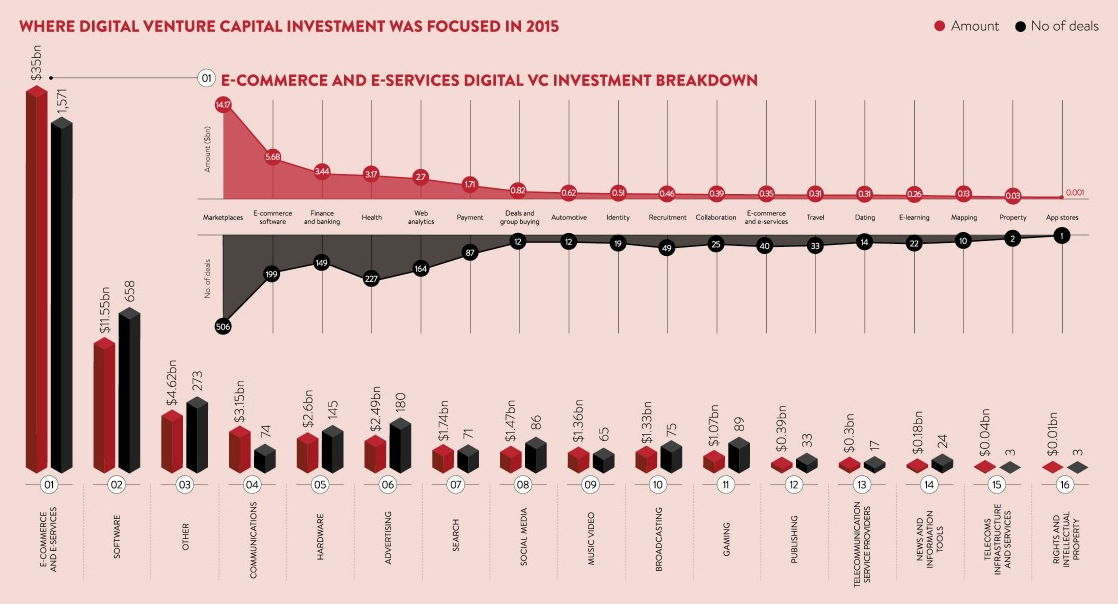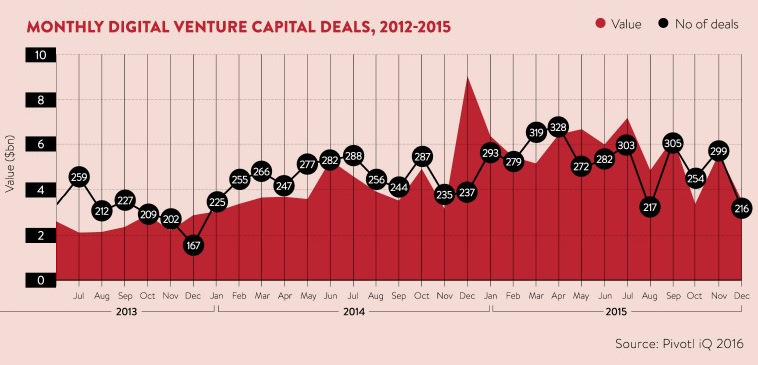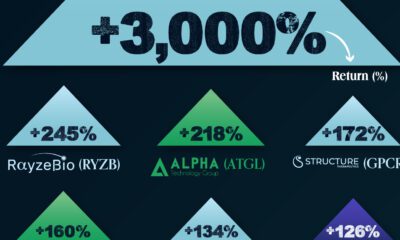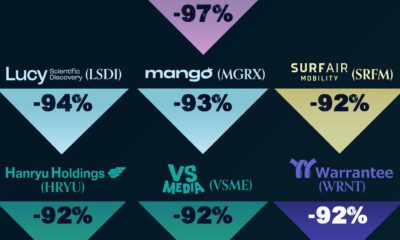Technology
The Slowdown in Venture Capital Deals is a Cause for Concern

Last year, the market for venture capital soared to new heights. A record amount of money was raised, with global funding for VC-backed companies reaching $128.5 billion, a 44% jump from 2014.
However, this impressive annual data doesn’t show the whole picture. The fact of the matter is that the flow of venture capital deals peaked mid-year, and then began to disintegrate in the autumn.
Here’s another look, this time with quarterly data from CB Insights:
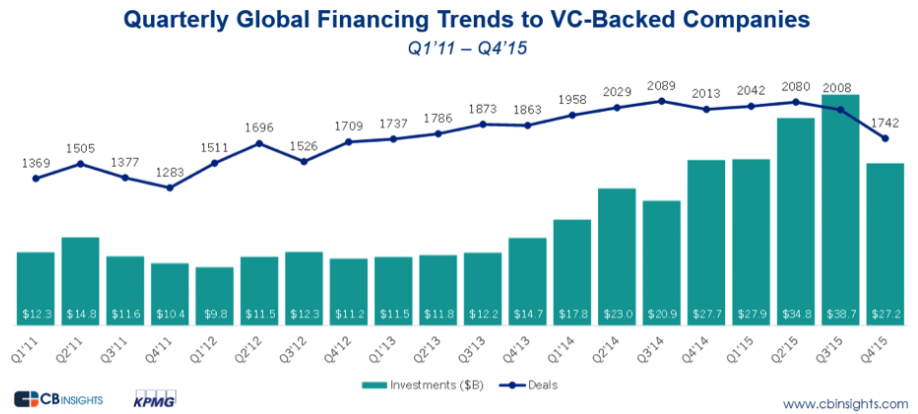
The data for Q4 is a steep drop off in terms of deal-flow, and this number hasn’t been this low since Q1 of 2013. The better news is that a total of $27.2 billion was raised, which is more or less on par with previous quarters.
What’s Happening?
Venture capital stalwarts have noted that this lack of deals could be a blip on the radar.
“I’m not aware of any VC who pays attention to any quarter to quarter data at all,” Marc Andreessen, a prominent name in venture capital, noted in a Forbes piece.
That said, a sudden slowdown of this magnitude does raise questions. This is especially true given some of the market developments of 2015.
Firstly, this slowdown in venture capital deals has corresponded with the general anxiety and volatility occurring in public markets. Further, it’s also occurring on the heels of several less-than-stellar IPO performances and repeated calls of a tech valuation bubble. Lastly, while 2015 set records in terms of dollars spent in terms of funding, the amount of new capital raised by venture capital funds dipped significantly from 2014 levels.
This evidence would suggest that venture capital firms, as well as those that fund them, are becoming more discriminatory in how they spend their money.
Venture Capital in 2015: At a Glance
Where did venture capital money go to in 2015?
Here are some further charts from Raconteur that show the distribution behind the 100 biggest venture capital deals:
Top 100 Deals by Region
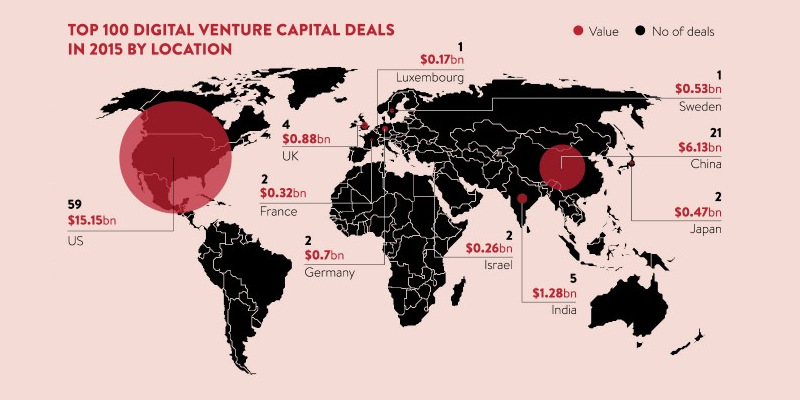
10 Largest Raises in Digital
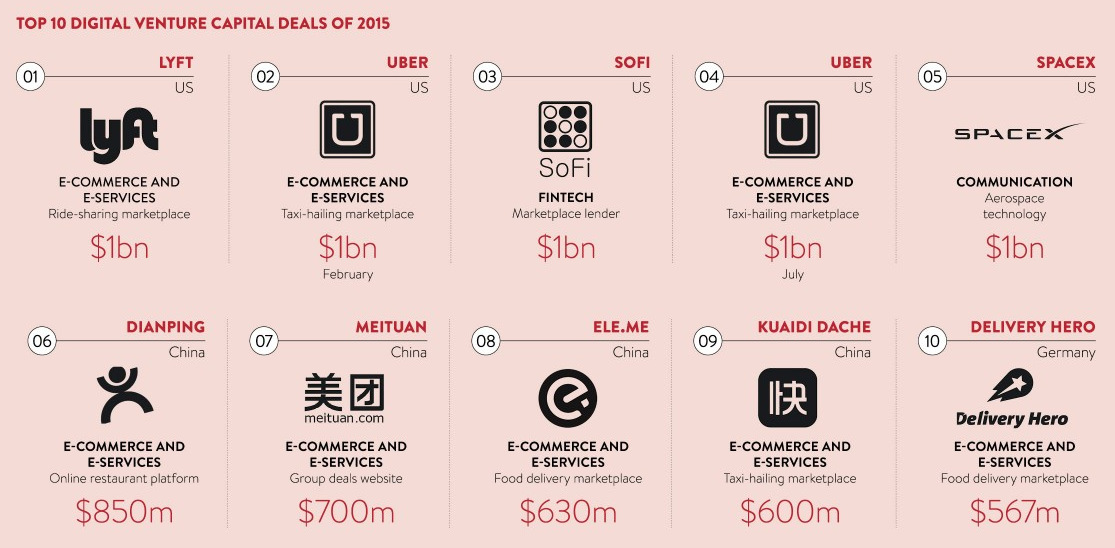
Digital Deals by Sector
Click image to expand
Technology
Visualizing AI Patents by Country
See which countries have been granted the most AI patents each year, from 2012 to 2022.

Visualizing AI Patents by Country
This was originally posted on our Voronoi app. Download the app for free on iOS or Android and discover incredible data-driven charts from a variety of trusted sources.
This infographic shows the number of AI-related patents granted each year from 2010 to 2022 (latest data available). These figures come from the Center for Security and Emerging Technology (CSET), accessed via Stanford University’s 2024 AI Index Report.
From this data, we can see that China first overtook the U.S. in 2013. Since then, the country has seen enormous growth in the number of AI patents granted each year.
| Year | China | EU and UK | U.S. | RoW | Global Total |
|---|---|---|---|---|---|
| 2010 | 307 | 137 | 984 | 571 | 1,999 |
| 2011 | 516 | 129 | 980 | 581 | 2,206 |
| 2012 | 926 | 112 | 950 | 660 | 2,648 |
| 2013 | 1,035 | 91 | 970 | 627 | 2,723 |
| 2014 | 1,278 | 97 | 1,078 | 667 | 3,120 |
| 2015 | 1,721 | 110 | 1,135 | 539 | 3,505 |
| 2016 | 1,621 | 128 | 1,298 | 714 | 3,761 |
| 2017 | 2,428 | 144 | 1,489 | 1,075 | 5,136 |
| 2018 | 4,741 | 155 | 1,674 | 1,574 | 8,144 |
| 2019 | 9,530 | 322 | 3,211 | 2,720 | 15,783 |
| 2020 | 13,071 | 406 | 5,441 | 4,455 | 23,373 |
| 2021 | 21,907 | 623 | 8,219 | 7,519 | 38,268 |
| 2022 | 35,315 | 1,173 | 12,077 | 13,699 | 62,264 |
In 2022, China was granted more patents than every other country combined.
While this suggests that the country is very active in researching the field of artificial intelligence, it doesn’t necessarily mean that China is the farthest in terms of capability.
Key Facts About AI Patents
According to CSET, AI patents relate to mathematical relationships and algorithms, which are considered abstract ideas under patent law. They can also have different meaning, depending on where they are filed.
In the U.S., AI patenting is concentrated amongst large companies including IBM, Microsoft, and Google. On the other hand, AI patenting in China is more distributed across government organizations, universities, and tech firms (e.g. Tencent).
In terms of focus area, China’s patents are typically related to computer vision, a field of AI that enables computers and systems to interpret visual data and inputs. Meanwhile America’s efforts are more evenly distributed across research fields.
Learn More About AI From Visual Capitalist
If you want to see more data visualizations on artificial intelligence, check out this graphic that shows which job departments will be impacted by AI the most.
-

 Markets1 week ago
Markets1 week agoU.S. Debt Interest Payments Reach $1 Trillion
-

 Markets2 weeks ago
Markets2 weeks agoRanked: The Most Valuable Housing Markets in America
-

 Money2 weeks ago
Money2 weeks agoWhich States Have the Highest Minimum Wage in America?
-

 AI2 weeks ago
AI2 weeks agoRanked: Semiconductor Companies by Industry Revenue Share
-

 Markets2 weeks ago
Markets2 weeks agoRanked: The World’s Top Flight Routes, by Revenue
-

 Countries2 weeks ago
Countries2 weeks agoPopulation Projections: The World’s 6 Largest Countries in 2075
-

 Markets2 weeks ago
Markets2 weeks agoThe Top 10 States by Real GDP Growth in 2023
-

 Money2 weeks ago
Money2 weeks agoThe Smallest Gender Wage Gaps in OECD Countries

